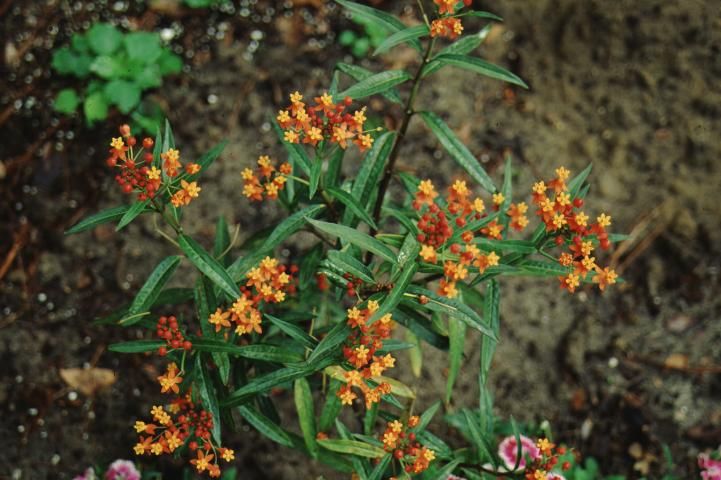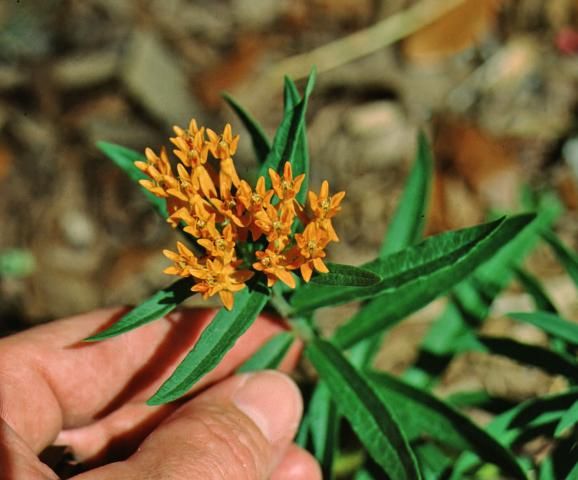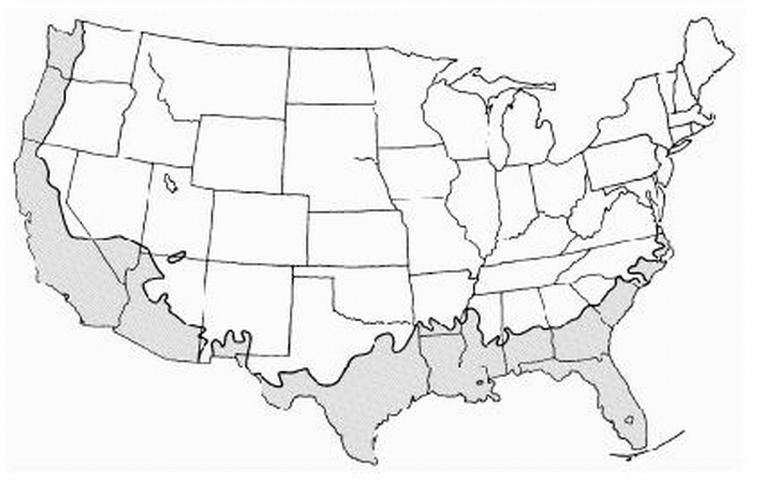Introduction
Butterfly weed is a member of the milkweed family. The plants grow to two feet tall and flower from July to September. The flower colors are orange, red, and yellow. The plant will not flower freely until well-established. The best sites have exposure to sun or partial shade and almost any soil. The plant tolerates dry soil but not heavy soil. Butterfly weed is slow to start growth in the spring. Mark its location to prevent damage to easily injured dormant crowns. A taproot makes transplanting difficult. Once established do not disturb butterfly weed unnecessarily.

Credit: Edward F. Gilman, UF/IFAS

Credit: Edward F. Gilman, UF/IFAS
General Information
Scientific name: Asclepias tuberosa
Pronunciation: as-KLEE-pee-us too-bur-O-suh
Common name(s): butterfly weed, Indian paintbrush, butterfly milkweed
Family: Apocynaceae
Plant type: herbaceous; annual
USDA hardiness zones: 8 through 10 (Figure 3)

Planting months for zone 7: June; July
Planting months for zone 8: May; June; July; August
Planting months for zone 9: March; April; May; June; July; August; September
Planting months for zone 10 and 11: February; March; April; May; June; July; August; September; October; November; December
Origin: native to Florida
Invasive potential: may self-seed each year
Uses: naturalizing; cut flowers; attracts butterflies; mass planting; attracts hummingbirds
Availability: somewhat available, may have to go out of the region to find the plant
Description
Height: 2 to 3 feet
Spread: 2 to 3 feet
Plant habit: round; upright
Plant density: moderate
Growth rate: fast
Texture: medium
Foliage
Leaf arrangement: alternate
Leaf type: simple
Leaf margin: entire
Leaf shape: oblong
Leaf venation: parallel
Leaf type and persistence: deciduous
Leaf blade length: 4 to 8 inches
Leaf color: green
Fall color: not applicable
Fall characteristic: not applicable
Flower
Flower color: red; yellow
Flower characteristic: summer-flowering; spring-flowering
Fruit
Fruit shape: unknown
Fruit length: unknown
Fruit cover: unknown
Fruit color: unknown
Fruit characteristic: inconspicuous and not showy
Trunk and Branches
Trunk/bark/branches: not applicable
Current year stem/twig color: green
Current year stem/twig thickness: thick
Culture
Light requirement: plant grows in full sun
Soil tolerances: acidic; sand; loam; clay
Drought tolerance: moderate
Soil salt tolerance: poor
Plant spacing: 18 to 24 inches
Other
Roots: not applicable
Winter interest: no special winter interest
Outstanding plant: plant has outstanding ornamental features and could be planted more
Pest resistance: very sensitive to one or more pests or diseases which can affect plant health or aesthetics
Use and Management
As the name implies, this is one of many small plants that attract butterflies to the landscape. One to several plants is usually all that is needed to draw butterflies to the garden. There are reports that Asclepias has a tendency to escape cultivation and may seed into the landscape. They grow naturally in dry, sandy soil along roadsides from New England to Colorado, Texas and into Florida.
Raw roots have been eaten to treat bronchial ailments. Roots have also been taken internally for intestinal gas, hemorrhaging, and other ailments.
Propagation is by seed or division in the spring. The seed germinates in 3 to 4 weeks at 70°F to 75°F. Plants may be planted in a cold frame in spring or fall. Fresh seed may need chilling.
Design Considerations
The thin stems and widely spaced leaves of the butterfly weed (Indian paintbrush) give a slightly weedy appearance (hence the name) so most gardeners mix them with shorter plants where the bright red, orange, and yellow flowers can be easily seen above the ground cover. The leaves can be stripped by caterpillars and the plant often looks stick-like at certain times of the year so using ground cover also helps hide the bare stems until they can be cut back. Pair with plants with large foliage and mounding or loose spreading forms to help the butterfly weed poke through the plants. White or purple flowers are complementary colors to yellow and red, which will contrast nicely.
Pest and Diseases
Aphids may infest butterfly weed.
Leaf spot diseases are seen but not serious.
Rusts cause the formation of reddish-colored spots.
Cucumber mosaic virus causes leaf mottling, but no chemical control is available.